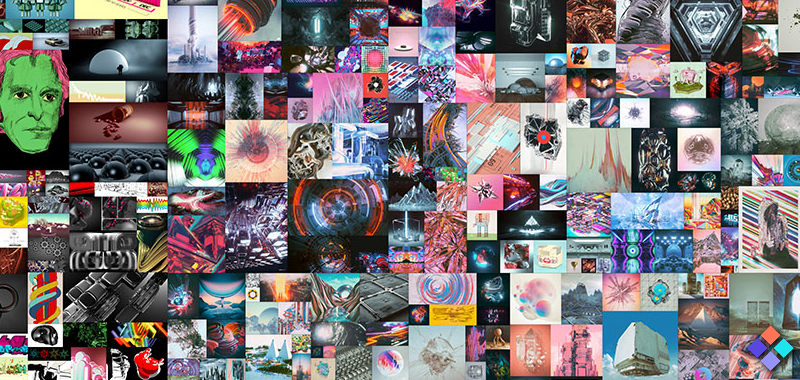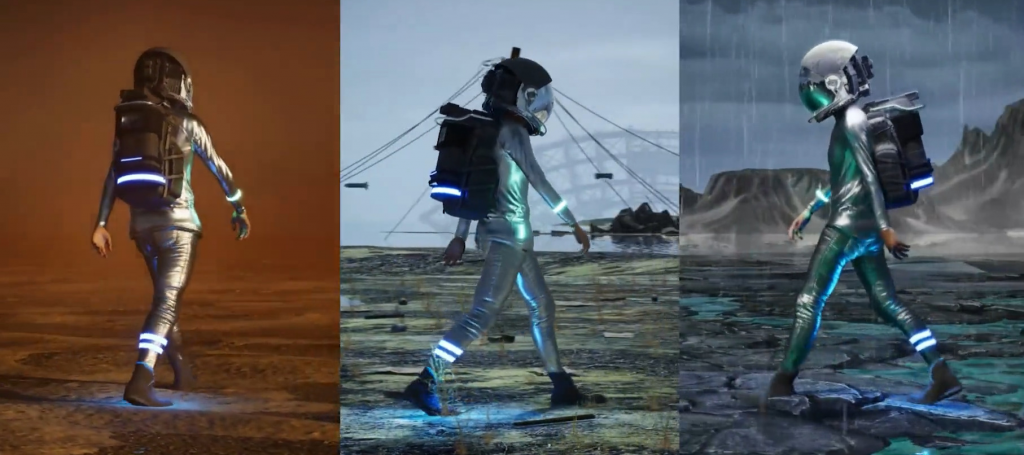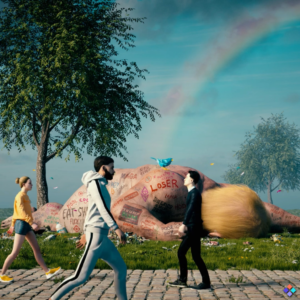NFTs have been around for a while, but they did not gain popularity until 2021. However, the market has grown significantly since then. While they have exciting potential, they are well-known for their high prices and celebrity adoptions. Some NFTs have had more success and made more money than others.
PFP NFTs are currently the most widely used NFTs. Because of their massive sales, they have also received the most mainstream attention and population. However, NFT artworks have also achieved considerable success.
Table of Contents
What are NFT artworks?
NFT artworks are artworks that have been converted into NFTs and placed on the blockchain. Making them into NFTs adds authenticity to the artwork and makes it easier to prove ownership.
The fact that they have been converted into NFTs does not imply that the artwork has been stored on the blockchain. Instead, the NFT stores information about the artwork and assigns it a unique token I.D. The artwork is then stored on the blockchain, and ownership and sales are recorded as a result.
Using NFTs to sell artwork is more advantageous to artists than traditional methods. Using NFTs frees artists from reliance on galleries and introduces a royalty scheme that benefits artists more. As a result, it is not surprising that NFT artwork gained popularity and acceptance quickly.
There is no way of knowing how much an NFT artwork is worth, as there is with traditional art. You can only tell how much someone is willing to pay for it, and NFT arts sales have consistently broken records since their rise.
Let’s take a look at the top seven most expensive NFT artworks ever sold.
EVERYDAYS: THE FIRST 5000 DAYS ($69,346,250)

Everydays: The First 5000 Days is an NFT artwork by Mike Winkelmann, also known as Beeple. The artwork is a collection of 5,000 digital pieces he created on a daily basis between May 1, 2007, and January 7, 2021.
The NFT was sold at a Christie’s auction to Singapore-based crypto investor Vignesh Sundaresan, launching NFTs into the limelight. However, the sale has been fraught with controversy, including rumours that Sundaresan and Beeple planned the sale to draw attention to another speculative asset owned by Beeple.
HUMAN ONE ($28,985,000)

Human One is another NFT piece by Beeple that sold at Christie’s 21st Century Evening auction on November 10, 2021.
A generative sculpture that combines physical and digital art depicts an astronaut suit walking forward, enduring various weather and biomes. Beeple still has access to the piece and plans to evolve its content for the rest of his life because the NFT is a dynamic NFT that can change form.
CLOCK ($20,218,310)
The clock is an NFT art piece by anonymous digital artist Pak, who is still the highest-grossing NFT artist, with several collections and individual NFT art selling for millions of dollars.
The NFT, as the name implies, is a clock that tracks the number of days Julian Assange has been imprisoned in London’s Belmarsh Prison.Pak and Assange collaborated to establish this NFT in order to help fund Assange’s legal defence.
CROSSROADS ($6,600,000)

Beeple’s third entry on this list, Crossroads, features a generative NFT of a large man lying face-flat in the background.
The work is an example of dynamic art in the sense that it can change form and shape, and it is one of the earliest examples of dynamic art. Beeple created the artwork ahead of the 2020 U.S. presidential election between Donald Trump and Joe Biden and revealed that the outcome of the election would cause the NFT artwork to change. Donald Trump lost the elections, leaving us with the NFT’s final form: a gratified and mocked man lying face down on the floor.
Read also: Yuga Labs Launches the Skill-Based NFT Mint
Ocean Front: $6,000,000

Beeple is well-known for his record-breaking sales, but the digital artist also uses his art to reflect people’s everyday lives and challenges. Ocean Front is an NFT piece in this vein.
The piece depicts climate change and the precarious state of the world by balancing minivans and trailers on scaffolding, with a tree at the very top. It is also included in the groundbreaking Everyday collection.
Justin Sun, the founder and CEO of the Tron Foundation, purchased the NFT for $6 million. The sale proceeds were then donated to the Open Earth Foundation, a non-profit organisation that raises awareness about climate change.
REPLICATOR ($4,144,000)

Creativity and ingenuity are characteristics that contribute to the uniqueness of art pieces. These characteristics were common in traditional art pieces. Michah Dowbak, also known as Mad Dog Jones, reminds us why some pieces sell for so much money in this piece.
The NFT artwork, Replicator, is a 50-second looped video that tells the story of a machine through time. Through a digital image of a photocopier in a Los Angeles office space, the artwork depicts the accelerating wave of development and demonstrates how quickly recent technologies are becoming obsolete.
The NFT is also a dynamic NFT that can change shape in response to a specific event, time, or trigger. The smart contract embedded in the NFT enables this change. The first artwork serves as the inspiration for seven other NFTs, each of which would replicate the previous piece and tell a unique story about the machine through time. Eventually, the series concludes with a seventh piece called the JAM.
Stay Free (Edward Snowden, 2021) ($2,709,899)
Stay Free (Edward Snowden) is an NFT artwork that demonstrates how NFTs can be used for a variety of purposes. This NFT serves a similar function to Pak’s Clock. In this case, however, Edward Snowden created the NFT rather than another artist.
The NFT features images of National Security Agency whistleblower Edward Snowden as well as pages from a court of appeals decision ruling that the mass surveillance programme Snowden exposed violated U.S. laws. Edward Snowden went into exile in Russia after leaking highly classified information about the mass surveillance programme in 2013. The proceeds from the sale were donated to the Freedom of the Press Foundation.
Read more NFT news: https://coinmicroscope.com/nft-news/
Related posts
When was the first presidential election in the US?
The election process in the world’s most powerful nation, the US, has come a long way. Various amendments have been made to the Constitution that allowed black men, white women and other disadvantaged groups to participate in the elections. Further amendments during the 60s and…
Tips & Trick For Healthy Glowing Skin
Lorem ipsum dolor sit amet, consectetur adipiscing elit. Nam laoreet, nunc et accumsan cursus, neque eros sodales lectus, in fermentum libero dui eu lacus. Nam lobortis facilisis sapien non aliquet. Aenean ligula urna, vehicula placerat sodales vel, tempor et orci. Donec molestie metus a sagittis…
My Fight With Depression. Concussions
Lorem ipsum dolor sit amet, consectetur adipiscing elit. Nam laoreet, nunc et accumsan cursus, neque eros sodales lectus, in fermentum libero dui eu lacus. Nam lobortis facilisis sapien non aliquet. Aenean ligula urna, vehicula placerat sodales vel, tempor et orci. Donec molestie metus a sagittis…
Top 10 most visited tourist places in the world
Lorem ipsum dolor sit amet, consectetur adipiscing elit. Nam laoreet, nunc et accumsan cursus, neque eros sodales lectus, in fermentum libero dui eu lacus. Nam lobortis facilisis sapien non aliquet. Aenean ligula urna, vehicula placerat sodales vel, tempor et orci. Donec molestie metus a sagittis…
How Digital Health Technology Is Beneficial?
Digital health revolves around the usage of diverse technological platforms including mobile health, teen health, configurable remote patient monitoring, etc to improve the connection between the patients and the doctors. Across the healthcare system, the horizon and scope of digital health have helped create opportunities…
How Latest Farmtrac Tractors are Improving Farming in India?
India mostly relies on farming, and a large part of the population depends on it for their livelihoods. Recently, there’s been a big shift towards using modern farming techniques and machinery to make farming more productive and efficient. A good example of this is the…
Dispelling Myths: Demystifying Rx Waste and Expiration Dates – WasteX Pharmaceutical Waste Disposal Separates Fact from Fiction
The specter of “expired” medication looms large, conjuring images of potent chemicals wreaking havoc on water sources and ecosystems. But before you panic toss that bottle of pills, let’s delve into the truth about pharmaceutical waste and expiration dates, separating fact from fiction. At WasteX…
Sustainable Living in Memphis: Green Initiatives and Eco-Friendly Hotspots
Memphis, a city known for its rich cultural heritage and vibrant atmosphere, is increasingly becoming a hub for sustainable living. As environmental awareness continues to grow, residents and businesses in Memphis are embracing green initiatives and fostering eco-friendly practices. Let’s explore the city’s commitment to…
Today's pick
Hot topics
Stay connected
Meet the Author

Gillion is a multi-concept WordPress theme that lets you create blog, magazine, news, review websites. With clean and functional design and lots of useful features theme will deliver amazing user experience to your clients and readers.
Learn moreCategories
- Animals (7)
- Apps & Softwares (8)
- Automotive (8)
- Beauty (8)
- Business (141)
- Cars (12)
- Cartoon (3)
- Cook (4)
- Cooking (1)
- Design (8)
- Economy (6)
- EDUCATION (25)
- Entertainment (16)
- Fashion (23)
- Fitness (2)
- Food (16)
- Gaming (51)
- Guide (20)
- Health (119)
- Home (52)
- Home improvement (12)
- Interior (3)
- Law (16)
- Life (1)
- LifeStyle (99)
- Marketing (5)
- Motivation (9)
- Movie (6)
- Movies (1)
- Music (3)
- News (8)
- Painting Art (1)
- People (15)
- Photography (7)
- Review (113)
- Services (7)
- Social Media (6)
- Sport (9)
- Sports (12)
- Style (10)
- Swimming (1)
- Tech (125)
- Travel (26)
- Uncategorized (17)
- Vape (5)
- Western (3)
- World (2)










